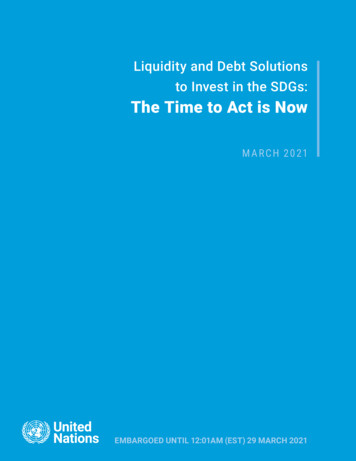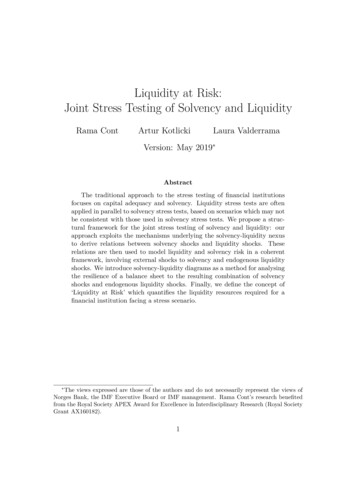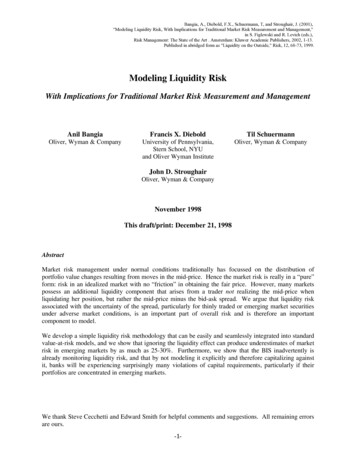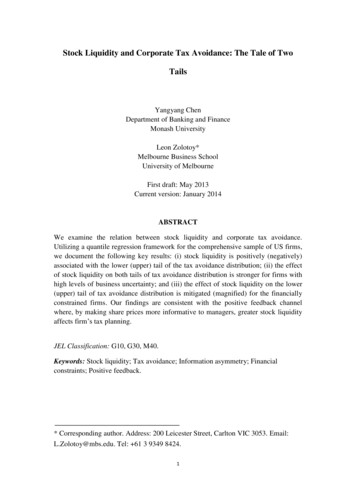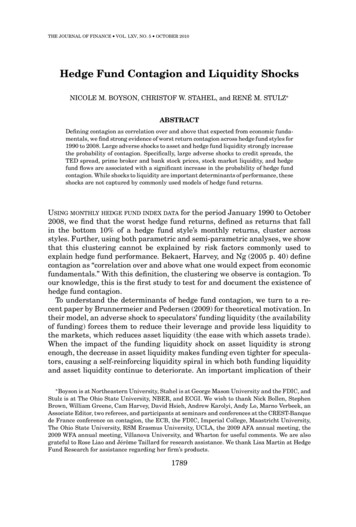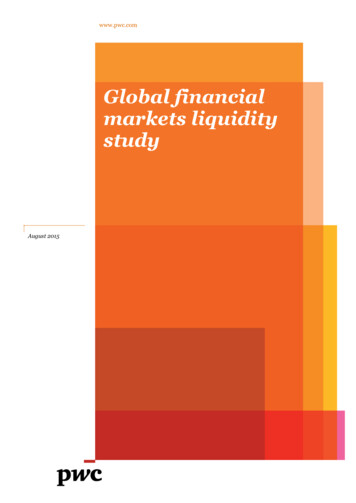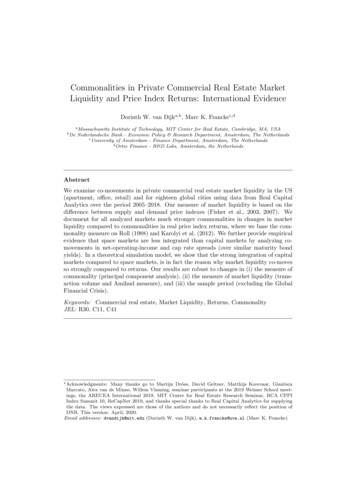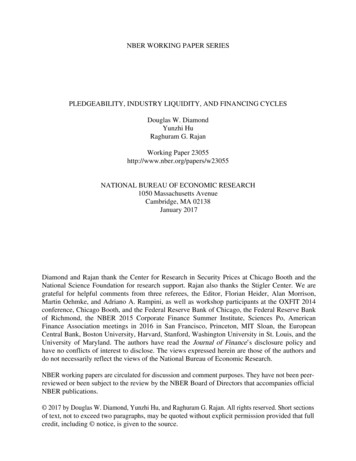
Transcription
NBER WORKING PAPER SERIESPLEDGEABILITY, INDUSTRY LIQUIDITY, AND FINANCING CYCLESDouglas W. DiamondYunzhi HuRaghuram G. RajanWorking Paper 23055http://www.nber.org/papers/w23055NATIONAL BUREAU OF ECONOMIC RESEARCH1050 Massachusetts AvenueCambridge, MA 02138January 2017Diamond and Rajan thank the Center for Research in Security Prices at Chicago Booth and theNational Science Foundation for research support. Rajan also thanks the Stigler Center. We aregrateful for helpful comments from three referees, the Editor, Florian Heider, Alan Morrison,Martin Oehmke, and Adriano A. Rampini, as well as workshop participants at the OXFIT 2014conference, Chicago Booth, and the Federal Reserve Bank of Chicago, the Federal Reserve Bankof Richmond, the NBER 2015 Corporate Finance Summer Institute, Sciences Po, AmericanFinance Association meetings in 2016 in San Francisco, Princeton, MIT Sloan, the EuropeanCentral Bank, Boston University, Harvard, Stanford, Washington University in St. Louis, and theUniversity of Maryland. The authors have read the Journal of Finance’s disclosure policy andhave no conflicts of interest to disclose. The views expressed herein are those of the authors anddo not necessarily reflect the views of the National Bureau of Economic Research.NBER working papers are circulated for discussion and comment purposes. They have not been peerreviewed or been subject to the review by the NBER Board of Directors that accompanies officialNBER publications. 2017 by Douglas W. Diamond, Yunzhi Hu, and Raghuram G. Rajan. All rights reserved. Short sectionsof text, not to exceed two paragraphs, may be quoted without explicit permission provided that fullcredit, including notice, is given to the source.
Pledgeability, Industry Liquidity, and Financing CyclesDouglas W. Diamond, Yunzhi Hu, and Raghuram G. RajanNBER Working Paper No. 23055January 2017, Revised June 2020JEL No. E00,E02,E59,G20,G21,G31,G33ABSTRACTWhy do firms choose high debt when they anticipate high valuations, and underperformsubsequently?We propose a theory of financing cycles where the importance of creditors’ controlrights over cash flows (“pledgeability”) varies with industry liquidity. The market allows firmstake on more debt when they anticipate higher future liquidity. However, both high anticipatedliquidity and the resulting high debt limit their incentives to enhance pledgeability. This hasprolonged adverse effects in a downturn. Because these effects are hard to contract upon, higheranticipated liquidity can also reduce a firm’s current access to finance.Douglas W. DiamondBooth School of BusinessUniversity of Chicago5807 S Woodlawn AvenueChicago, IL 60637and NBERdouglas.diamond@chicagobooth.eduYunzhi HuCB #3490University of North CarolinaCB #3490, 4103 McColl BuildingChapel Hill, NC 48823United StatesYunzhi Hu@kenan-flagler.unc.eduRaghuram G. RajanBooth School of BusinessUniversity of Chicago5807 South Woodlawn AvenueChicago, IL 60637and NBERraghuram.rajan@ChicagoBooth.edu
Why do downturns following episodes of high firm valuations result in more protracted recessions (seeKrishnamurthy and Muir (2017) and López-Salido, Stein, and Zakrajšek (2017))? 1 One traditionalrationale is based on the idea of “debt overhang” – debt built up during the boom restricts investment andborrowing during the bust. However, if everyone knows that debt reduces investment, debt holders havean incentive to write down the debt in return for a stake in the firm’s growth. For debt overhang to be aserious concern, the firm and debt holders must be unable to negotiate value-enhancing contracts. Anotherview is that borrowers cannot be trusted to pursue only value-enhancing investments, even in a downturn,in which case debt overhang is needed to constrain the borrower’s investment – overhang is a second-bestsolution to a fundamental moral hazard problem (see Hart and Moore (1995) or Shleifer and Vishny(1992)). The immediate questions raised by the latter view is why would we want to constrain borrowersmore in bad times following high valuations, when the constraints imposed by debt are already high, andwhy would the moral hazard problem be so much more serious in such episodes.In this paper we provide an explanation for high debt and show why its consequences are moreacute following periods of high valuations and rational optimism about future values. In doing so, wedifferentiate between financier control rights that are due solely to high resale prices for assets and controlrights that derive from pledging cash flows. The former are especially useful in enforcing claims duringan asset price boom, while the latter facilitate enforcement of external claims at other times, includingdownturns. The transition between regimes in which the importance of control rights associated with cashflows differ significantly causes the debt built up during a boom to have prolonged adverse effects duringa downturn.To be more specific, consider an industry that requires special industry knowledge to produce.Within the industry, there are firms run by incumbents, there are experts (those who know the industrywell enough to be able to run firms as efficiently as the incumbents), and there are industry outsiders(such as financiers who do not know how to run industry firms but have general managerial/financialskills).Financiers have two sorts of control rights: control through the right to repossess and sell theunderlying asset being financed if payments are missed, and control over the cash flows generated by theasset. The first right only requires the frictionless enforcement of property rights in the economy, whichwe assume. This right is particularly valuable when a large number of capable potential buyers are willing1Krishnamurthy and Muir (2017) document a negative correlation between pre-crisis spreads and credit growth, aswell as a positive correlation between the change in spread as the crisis hits and the severity of the subsequent crisis.López-Salido, Stein, and Zakrajšek (2017) show that narrow credit spreads predict a slowdown in real activity insubsequent years, including in GDP growth, investment, consumption, and employment.2
to pay a high price for the firm’s assets. Greater wealth among experts (which we term industry liquidity)increases the availability of this asset-sale-based financing. Because we analyze a single industry, highlevels of this industry liquidity can be interpreted as an economy-wide boom.The second type of control right is conferred on creditors by the firm’s incumbent manager as shemakes the firm’s cash flows more appropriable by, or pledgeable to, creditors over the medium term. Forexample, she could improve accounting quality or set up escrow accounts so that cash flows are hard todivert. In general, an increase in experts’ higher prospective wealth (that is, liquidity) as well as in theirability to borrow against the future cash flows of the firm they buy (that is, pledgeability) will increasetheir bids for the firm. In turn, higher prospective bids will increase debt recovery, and thus thewillingness of creditors to lend up front. It therefore follows that higher liquidity and pledgeabilityincrease the firm’s debt capacity.However, pledgeability is endogenously determined. Consider the incentives of an incumbentfirm manager while choosing cash flow pledgeability for the next period. We assume that she may sellsome or all of the firm next period with some probability, either because she is no longer capable ofrunning it or because she needs to raise capital for new investment. If she owned the firm and had no debtclaims outstanding, she would undoubtedly want to increase pledgeability, especially if the direct costs ofdoing so are small – this would simply increase the amount that she would obtain by selling the firm toexperts if she lost ability to run the firm. If she has taken on debt, however, enhancing cash flowpledgeability is a double-edged sword. Higher bids from experts also allow existing creditors to collectmore if the incumbent stays in control because creditors have the right to seize assets and sell them whennot paid in full. In such situations, the incumbent has to “buy” the firm from creditors by outbiddingexperts (or paying debt fully). The higher the probability that she retains ability and stays in control, andthe higher the outstanding debt, the lower her incentives to raise pledgeability. Higher outstanding debtthus reduces the incumbent manager’s incentives to raise pledgeability.Now consider the effect of industry liquidity on pledgeability choice. If experts are rational, theywill never pay more for the firm than its fundamental value. When future industry liquidity is very high,experts will have enough wealth to buy the firm at full value without needing to borrow more against thefirm’s future cash flows. If so, higher pledgeability has no effect on how much experts will bid to pay forthe firm. In other words, high future liquidity crowds out the need for pledgeability in enhancing debtrepayments. We therefore have two influences on pledgeability – the level of outstanding debt and theanticipated liquidity of experts. The key results of the paper stem from the interaction between the two.3
To see this, consider a prospective boom, which is anticipated with high probability, duringwhich experts will have plenty of wealth. Repayment of any corporate borrowing today is enforced bythe potential high resale value of the firm – at the future date, wealthy experts will bid full value for thefirm as in Shleifer and Vishny (1992), without needing high pledgeability to make their bid. The highanticipated resale value increases the promised payment that a firm can credibly repay and thus theamount it can borrow today (see Acharya and Viswanathan (2011)).Since pledgeability is not needed to enforce repayment in a future highly liquid state, a highprobability of such a state encourages creditors to lend large amounts to the incumbent up front, eventhough they know that doing so crowds out the incumbent’s incentives to enhance pledgeability, and evenif there is a possible low liquidity state in which pledgeability is needed to enhance creditor rights.Prospective liquidity thus encourages borrowing, which can crowd out pledgeability. Consequently, if thelow-liquidity state is realized, the enforceability of the firm’s debt, as well as its borrowing capacity, willfall significantly because pledgeability has been set low. Experts, also hit by the downturn, no longer havemuch personal wealth, nor does the low-cash-flow pledgeability of the firm allow them to borrow againstfuture cash flows to pay for the firm. The adverse effect of anticipated liquidity on pledgeability viahigher leverage is a key new focus of this paper.Since external claims are high in these low-liquidity episodes, the firm may be sold to outsiders.While industry outsiders have little ability to operate the firm themselves, this may be a virtue – outsidershave strong incentives to improve cash flow pledgeability because they do not want to own the firm longterm, but rather want to sell the firm back to experts at a high price. Outsiders play a critical role,therefore, not because they are flush with funds, but because they are not subject to moral hazard overpledgeability in the face of substantial debt.Importantly, creditors have little incentive to renegotiate fixed debt claims down during adownturn, since reallocation of the firm to industry outsiders may be the outcome that maximizes theirclaims, given past pledgeability choices. Consequently, in a downturn following a boom, a larger numberof the new asset owners will be less-productive industry outsiders, reducing average productivity. Eisfeldtand Rampini (2006, 2008) provide evidence consistent with this argument.Eventually, as the economy recovers, the outsiders sell the assets back to the more productiveexperts, as their higher pledgeability increases experts’ ability to raise money against future cash flows.Recoveries following an asset price boom and high leverage are thus delayed, not just because debt has tobe written down – where frictions in writing down debt would increase the length of the delay – but alsobecause firms have to restore the pledgeability of their cash flows to cope in a world in which liquidity is4
scarcer. It is the need to raise pledgeability that may prolong the downturn. Higher anticipated liquidity insome future states can therefore induce more eventual misallocation in less liquid states, a spillover effectbetween states that operates through leverage and pledgeability! Importantly, we will show that, throughits effect on leverage and pledgeability, higher anticipated liquidity can reduce the amount of funding thatcan be raised up front.All this suggests a financing cycle in the amount of leverage available to firms. In booms, whenhigh future resale prices (as opposed to fire-sale prices) for assets are likely, financial markets allowfirms to raise more with extremely high promised debt repayment. Such booms can be followed by busts,with the ability to raise debt financing lower than normal because pledgeability was previously set low.The economy need not oscillate only between booms and busts. In normal times, when anticipatedliquidity is lower than that prevailing in booms, the credit market will naturally limit the amount that anincumbent promises, so as to ensure that she has incentives to keep pledgeability high. Indeed, firms willbe able to raise more with moderate promised payments than with very high promised payments.Effectively, the financial market provides a lower leverage limit at such times.The leverage overhang on the pledgeability choice resembles traditional debt overhang (Myers(1977)), whereby decisions of equity-maximizing managers, such as investment, are distorted when theycause an increase in the value of outstanding debt. The pledgeability decision that we model is similarlydistorted because while benefiting the incumbent by raising the firm’s resale value, it also helps creditorscollect payments.Our model is also related to Jensen (1986). In Jensen (1986), leverage alone is sufficient to getmanagers to pay out free cash flow. Instead, we argue that the extent of “free” cash flow is endogenous,with one of the effects of high debt being that firm managers tunnel even more cash flow out of the firm,thus “freeing” it. As Jensen (1997) argues, and our model suggests, the prospective future sale of the firmin management buyouts may be what is needed to incentivize management to not tunnel.Our paper is most closely related to Shleifer and Vishny (1992) and Eisfeldt and Rampini (2008),as we discuss in Section I below where we lay out the model. Our paper also explains why asset pricebooms based on a combination of liquidity and leverage can be fragile (see, for example, Borio and Lowe(2002), Adrian and Shin (2010), and Rajan and Ramcharan (2015)), and offers a reason why credit cyclesemerge, though a dynamic extension to the model is needed to explain the properties of such cycles fully(see, for example, Kiyotaki and Moore (1997)). 2 More broadly, our paper provides theoretical2See Benmelech and Bergman (2011), Coval and Stafford (2007), and Shleifer and Vishny (2011) forcomprehensive reviews.5
underpinnings for financing cycles (Borio (2014)), where a simultaneous and sustained increase in assetprices and leverage could significantly increase the persistence of business cycle downturns.The rest of the paper is organized as follows. In Section I, we describe the basic framework andthe timing of decisions in a two-period model, and in Section II we provide two motivating examples.Section III proceeds with the formal analysis on pledgeability choices when financing is provided via debtcontracts. The maximum amount that can be pledged to outside investors is characterized, and thefundamental trade-offs in the model are explained. We discuss robustness of the model to alternativeassumptions in Section IV, and empirical implications and the relationship to the literature in Section V.Finally, in Section VI we conclude.I. The FrameworkA. The Industry and States of NatureConsider an industry with three dates (0, 1, 2) and two periods between these dates, with date tmarking the end of period t. A period is a phase of the financing cycle (see Borio (2014), for example),which extends over several years. At the beginning of each period, the state of the industry is realized.The industry can prosper in good state G with probability q , or can be distressed in bad state B withprobability of 1-q. In period 2, we assume that the industry returns to state G for sure – this is meant torepresent the long-run state of the industry (we model economic fluctuations but not apocalypse). Figure 1illustrates the possible states of nature.Figure 1. States of nature.6
B. Agents and the AssetThere are two types of agents in the economy. Expert (E) managers have high ability to producewith an asset, which we call the firm. Some mutual specialization is established over the period betweenthe incumbent expert manager and the firm, which creates a value to incumbency. Therefore, when thestate is G, only the expert manager in place at the beginning of that period t can produce cash flows Ctwith the asset over the period. In the B state, however, even an expert manager cannot produce cashflows. There are also inexpert industry outsiders who are low ability (L) managers. They cannot producecash flows regardless of the state. Financiers can be thought of as low-ability managers who have fundsto lend provided they break even. All agents are risk neutral. We ignore time discounting, which is just amatter of rescaling the cash flows.A high-ability expert manager retains her ability into the next period with probabilityotherwise she turns into a low-ability manager. Think ofθ 1,θ as the degree of firm stability. Intuitively, thecritical capabilities for success are likely to be stable in a mature firm, or in a firm in an industry withlittle technological innovation. However, in a young firm that has yet to settle into its strategic niche or inan industry with significant innovation, the critical capabilities for success can vary over time — amanager who is appropriate in a particular period may be ineffective in the next. This is the sense inwhich an incumbent can lose ability, which occurs with higher probability in a young firm or a changingindustry. As we will see below, an alternative interpretation is that (1 θ ) is the probability of arrival ofan investment opportunity or a funding need. Stabilityθ under that interpretation would be the degree towhich the firm has no future funding needs.The incumbent’s loss of ability in the next period becomes known to all shortly before the end ofthe current period. Loss of ability is not an industry-wide occurrence and is independent across managers.So even if a manager loses her ability, a large number of other experts are equally able to take her placenext period. If a new expert takes over at the end of the current period, she will shape the firm accordingto her idiosyncratic management style, producing cash flows with the firm’s assets in future periods ingood states. A manager’s (both the incumbent and other bidders) type next period is observable but notverifiable and hence cannot be written into contacts.C. Financial ContractsA manager can raise money from financiers against the asset by writing one-period financialcontracts. We focus on debt contracts with promised payments at the end of period t, denoted by Dt , formost of our analysis. We can justify this by assuming that the aggregate state st is observable but not7
verifiable. Below we will discuss how the analysis changes when the aggregate state st is verifiable andcontracts can be state-contingent.Having acquired control of the firm, the incumbent manager would like to keep the realized cashflow for herself rather than share it with financiers. Two types of financier control rights force themanager to repay the external claims. First, the financier automatically gets paid the “pledgeable” portionof the cash flow produced over the period, up to the amount of the financier’s claim. Second, just beforethe end of the period, the financier has the right to seize and auction the firm to the highest bidder if hehas not been paid in full. As in Hart and Moore (1994), giving financiers this right in case of default caninduce the borrower to pay more than the pledgeable cash flow this period. Below, we describe these twocontrol rights in more detail.D. Control Rights over Cash Flow: PledgeabilityLet us define cash flow pledgeability as the fraction of realized cash flows that are automaticallydirected to an outside financier. The incumbent chooses pledgeability this period. It is then embeddednext period, and persists for the entire period. Thus, pledgeability γ t 1 set in period t is the fraction ofperiod t 1’s cash flows that can be automatically paid to outside financiers. The range of feasiblepledgeability levels isγ t 1 [γ , γ ] , where γ and γ satisfy 0 γ γ 1 . In general, the range offeasible pledgeability levels is determined by the institutions supporting corporate governance (such asregulators, investigative agencies, laws, and the judiciary). Settingresults primarily for the case in which ε 0 ; positiveεγ t 1 γcosts ε 0. We present ouronly alters the results quantitatively. Whileany level of pledgeability between γ and γ is feasible, in equilibrium the incumbent will choose eitherγ t 1 γ or γ t 1 γ because, as will be clear shortly, the incumbent’s payoff is always linear inpledgeability γ t 1 .A manager can tunnel cash flows out of the firm and into her pockets in a number of ways.Increasing pledgeability means closing off tunnels for cash flows generated by a future manager. Forexample, by moving to a simpler corporate structure today, or by making contracts with suppliers moretransparent with stricter rules on dealing with related parties, the incumbent ensures that future cash flowscannot be diverted to some nontransparent entity (see, for example, Rajan (2012)). By improving thequality of the accounting systems in place, including the detail and timeliness of disclosures, and byhiring a reputable auditor, the incumbent restricts the scope for future managers to play accounting gamesto hide cash flows. Any rapid shift from transparent accounting procedures to less transparent procedures,8
or from a reputable auditor to a less reputable auditor, would be noticed and invite closer scrutiny,defeating the objective of tunneling. Similarly, by taking on debt with strict financial covenants, such asminimum liquidity ratios, minimum collateral requirements, or sinking fund requirements, the incumbentensures that the firm is positioned to raise new debt with similar tough covenants when the current debtmatures, giving future lenders the confidence that cash flows will not be tunneled. More broadly, anystructure that enhances future corporate governance, and cannot be fully reversed quickly, enhancesfuture pledgeability.While the laxity of the general governance environment in a country determines γ , the scopefor an individual corporation to improve on it determines γ . Note also that while we assume thatpledgeability can be fixed for the next period, we do not assume that it is fixed permanently. Over time,accountant quality can decrease when accountants come up for rotation, for example, and as theenvironment itself changes, new ways of tunneling emerge. Allowing pledgeability to be chosen for onlythe next period captures the sense of fixity over the medium term but not over the long run.While a low-ability incumbent does not have industry-specific managerial ability to generate cashflows, he has general governance capabilities and can set next period’s pledgeability. Below we will seethat his inability to generate cash flows can sometimes be a benefit.E. Control Rights over Assets: Auction and ResaleIf creditors have not been paid in full from the pledged cash flows and any additional sum theincumbent voluntarily pays, then they get the right to auction the firm to the highest bidder at date t . Onecan think of such an auction as a form of bankruptcy. The incumbent manager who has failed to make thefull payment may also bid in this auction. Therefore, the incumbent can retain control by either paying offthe creditors in full (possibly by borrowing once again against future pledgeable cash flows) or by payingless than the full contracted amount and outbidding other bidders in the auction. The precise format of theauction does not matter, so long as what the incumbent is forced to pay rises with what other bidders arewilling to bid. We assume that the incumbent can always bid using other proxies, so contracts that banthe incumbent from participating in the auction after nonpayment are infeasible. Essentially, as in Hartand Moore (1994), we rule out “take-it-or-leave-it” threats from the lender that would allow him toextract all the cash the incumbent has without invoking the outside option of selling the asset to others.F. Initial Conditions and WealthLet ω1I , s1and ω1E , s1respectively be the wealth levels of the incumbent and experts in state s1,with the latter also termed industry liquidity. The wealth level of the incumbent is augmented by the9
unpledged cash flows she generates within the firmWe also assume that ω1E ,G(1 γ 1 ) C1 in state G but not in B, so ωI ,G1 ω1I , B . ω1E , B because industry prosperity lifts the private income of experts as theywork as contractors, consultants, or employees in the industry.We assume that at date 0, the firm already exists, put together by a founder who has to sell. Thereason for this sale is unimportant – the founder may want to retire, may have lost her ability, or may bebankrupt in which case the firm is being sold by the receiver. All that matters is that she sells out entirelyand thus wants the highest price. To simplify notation, for now we assume that each bidder must alwaysraise the largest amount from financiers to avoid being outbid. A sufficient condition to guarantee this isthat all potential bidders have no wealth at date 0 and compete by promising creditors the largest possiblepayment that is credible.G. EfficiencyThe measure of unconstrained economic efficiency that we use in the rest of this paper is theextent to which the asset is in the hands of the most productive owner at the time. We do not modelinvestment, but instead assume that the asset exists and can be bought by a bidder in an up-front auction.The auction determines the price of the asset and the type of incumbent. An alternative approach, whichfollows easily from the analysis, is to put a minimum scale on the value of real inputs to be assembledinto the firm at date 0, and assume that the firm starts at that date only if enough funding is available tobuy those inputs. As a result, inefficient underinvestment may occur if moral hazard (which we analyzeshortly) pushes available funds at date 0 below this floor. We illustrate an extreme consequence of thischannel later, with an example showing that higher liquidity ex post, working through leverage and lowerpledgeability, can actually reduce the amount raised up front.H. TimingThe timing of events is described in Figure 2. After the initial auction, the incumbent takes ondebt D1 that is due at date 1. We assume that the incumbent sets pledgeabilityγ 2 only knowing theprobability of states G and B. Next, the state is realized, and her ability in period 2 is known. Productionthen takes place and the pledgeable fractionγ 1 of cash flows (set in the previous period) goes tofinanciers automatically if state G is realized. The incumbent either pays the remaining balance due orenters the auction. The period ends with a new incumbent potentially in place.10
Figure 2. Timing and decisions in period 1.II. Two Motivating ExamplesIn this section we develop two examples where we illustrate three effects that together constitute thecore of our results. First, both high pledgeability and higher anticipated liquidity weakly enhanceenforceable debt repayment. Second, higher outstanding debt reduces the incumbent’s incentives to setpledgeability high. Third, higher anticipated liquidity reduces the need for high pledgeability in enforcingdebt repayment. Taken together, these three effects imply that higher anticipated liquidity may incentivizethe incumbent to take so much debt that she neglects pledgeability, but this may be the debt level thatallows her to raise the most funding up front. In sum, higher anticipated liquidity enhances leverage andcrowds out pledgeability.Let the parameters for the examples be given as follows: C1 0, C2 1, θ 0.5, γ 0.3, γ 0.6, ω1 0.8,I ,Gω1I , B 0, ω1E , B 0, γ 1 0, q 0.8, and ε 0 .EXAMPLE 1: Low anticipated industry liquidity: ω1E ,G 0.2.Debt repayment at date 1 is enforced by the lender, who can seize the firm and auction it toexperts. The incumbent has to either pay the amount due or match the auction price, and will choose topay the lower of the two, defaulting strategically if the anticipated auction price is less than the promiseddebt payment. Of course, if the incumbent loses ability, she has no option but to sell in an auction sinceshe cannot run the firm. She will use the auction proceeds to pay debt.Raising the pledgeability of future cash flows can increase the amount that experts can borrowagainst the firm and (weakly) increase their bids for the firm’s assets. Similarly, higher realized expertwealth or liquidity will also increase expert bids. In state G, an expert can bid using her personal wealth0.2 and the amount that she can borrow against future cash flows. If period-2 pledgeability has been sethigh (this is set earlier
Booth School of Business University of Chicago 5807 S Woodlawn Avenue Chicago, IL 60637 and NBER douglas.diamond@chicagobooth.edu Yunzhi Hu CB #3490 University of North Carolina CB #3490, 4103 McColl Building Chapel Hill, NC 48823 United States Yunzhi_Hu@kenan-flagler.unc.edu Raghuram G. Rajan Booth School of Business University of Chicago
